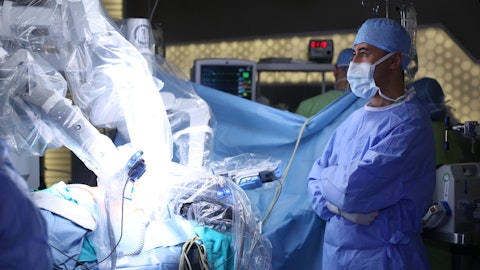Larry Biegelsen: Good afternoon. Thanks for taking the question. One, on your — Gary, your new system comments and one on the industrial scale comments that you made today at JPMorgan. So you talked about core technology changes often requiring the clinical trials and that you won’t launch a multi-port system in 2023. So Gary, my question is A, will you start a clinical trial and a new system in 2023; and B, if you did start a clinical trial, would you disclose that publicly even if the trial were outside the US, say, in a developing market?
Gary Guthart: Across our systems, we are doing trials in all sorts of places for all sorts of reasons, whether it’s SPI or otherwise. And — so the answer there is we have some places where those are publicly disclosed per normal rules. For competitive reasons, we don’t try to detail them too much, and that’s the position we’ll take going forward.
Larry Biegelsen: Good. Fair enough. And Gary, you talked a lot about — you used the term industrial scale a lot recently. What does that mean exactly? And what are the implications for Intuitive financially? Thank you.
Gary Guthart: I’ll take what does it mean and I’ll ask Jamie to help me on detailing on the finance side. One of the things that’s going on is that we are becoming well integrated into many surgical practices in several countries. I think that’s a great opportunity for us and a serious responsibility. As we’ve seen in the last couple of years with regard to supply chain robustness and other things, making sure that — we have supply chain stability that we want vertically integrating where we can. We have been doing that. A lot of the imaging pipeline work that we’ve done. We think that both gives us higher quality. It allows us to lower cost to the customer and it gives us robustness. We can plan for that robustness. That’s true not only in imaging, but in some core technologies and instruments and accessories.
And we think those are good long-term investments. So, that’s been really positive. There’s another place where our digital tools and our digital products, one of the things that’s going on that I think is powerful for the company is not just product architecture, but business architecture. And what I mean by that is that our supply chain can support multiple platforms in multiple countries around the world. It can — by that, I mean, multiport, single-port and Ion, our digital products architecture also is seamless and can integrate and support those platforms. So, that gives us a great quality advantage, it gives us a leverage capability, and allows us to lower the total cost for our customers and the cost to serve for our customers. Those things take some planning and some forward investment and it can be in core technology.
For example, in digital, it can be in facilities, in manufacturing base, so we can build our products. But it’s that opportunity. It’s a global opportunity to help support the standard of care in multiple countries. I think that the customer advantages are quite clear and I think the cost robustness and long-term durability advantages for the company are quite clear. But that takes some play out over time. Jamie, any help you’ll give?
Jamie Samath: I would just say industrial operating — industrial scale is linked to the capital expenditure plans that we’ve described, the $800 million to $1 billion of investment in 2023. I’d just add the financial ROI calculations on those investments are relatively straightforward. And we think there are real advantages in having large, highly automated factories that run at scale and that’s an advantage both for us and for our customers. So, the return calculations are relatively straightforward and they’re essentially the incremental gross margin dollars we can drive from growth.
Larry Biegelsen: All right. Thank you very much.
Gary Guthart: Thanks Larry.
Operator: Next we’ll go to line of Travis Steed with Bank of America. Please go ahead




